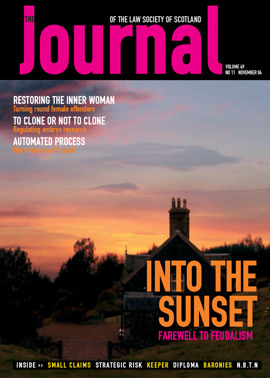Feudal law: not just a relic
As we all should know, 28 November 2004 (or rather “the appointed day”) and feudal abolition are now almost here. For some the past weeks and months have been a scene of increasing frenzy and frustration trying to understand the legislation and then serve and register preservation notices. Others may have found section 18 of the Abolition of Feudal Tenure etc (Scotland) Act 2000 something of a road less travelled.
Perhaps one of the beauties of feudal abolition will be no longer having to worry about feuduty and how to work it out. Like most if not all of my generation, the whole issue of feuduty was a somewhat irrelevant and pointless distraction. At university I was taught that the amount of feuduty was normally “derisory”, making the whole redemption procedure “particularly irksome”. Increasingly, purchasers have been invited to “take a view” on the whole issue.
It was something of a surprise to be asked recently what will happen to feuduty after 28 November 2004. When it turned out that the feuduty in question (which related to mineral interests) was some £8,000 per annum it acquired a rather greater degree of importance than had previously been the case. Just as well I hadn’t been purchasing the property and agreed to “take that view”.
Put simply (if that can ever be said of the 2000 Act), feuduty is extinguished on 28 November 2004. However, the former superior has until 28 November 2006 to serve notice on the former vassal requiring that compensation for loss of the feuduty be paid. As with calculating redemption of feuduty, the amount of compensation payable is determined by reference to the sum of money which would, if invested in 2 1/2% Consolidated Stock at the middle market price at the close of business on 26 November 2004, produce an annual sum equal to feuduty.
Not having had to go through this exercise since I was a trainee (and then only on a couple of occasions), I had some difficulty in immediately advising on how much 2 1/2% Consolidated Stock would deliver an annual return of £8,000. Consultation with the corporate department established which page of the Financial Times I should be looking at. Applying the maths was more difficult but ultimately established that the compensation figure at that date was £160,000. When five years’ arrears of feuduty was added this gave a grand total of around £200,000.
For most, feuduty is an anachronism with no relevance involving very little money at all but, as I discovered, for some it can be quite a hefty sum.
Needless to say the compensation notice is ready to be served awaiting the appointed day! Unless the right to pay by instalments is taken up by the former vassal, the full amount is payable 56 days after service. I am assuming that the former vassal will take up the right to pay by instalments.
As for the supplementary question I was asked, namely whether this sum is to be treated as capital or revenue – that is best left to the accountants.
Andrew Drane is a partner with Davidson Chalmers LLP, Edinburgh, heading the Construction and Projects Department
In this issue
- Drafting consumer contracts
- Virtual firms: transactional learning on the web
- Ignorantia juris: it's all Greek to me
- Sheriff Court Rules Council consultation paper
- The Clinical Trials Directive - a summary
- Guarding the inner sanctum
- Neighbours in the global village
- Family law: is it the path for you?
- From sunset to sunrise
- What next for conveyancing?
- An ethical minefield
- Shredding the evidence
- Robbing the poor?
- Our dynamic profession
- A wider angle
- Keep the eye on the ball
- A rough guide to becoming a partner
- Rediscovering hope
- Sharpen your pencils
- Significant other
- Too far or not enough?
- Chipping away the infringers?
- View from Holyrood
- Website reviews
- Book reviews
- The Registers and the Appointed Day
- Feudal law: not just a relic
- Birth of a register






